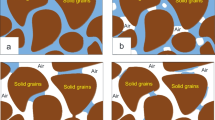Abstract
The paper presents sensitivity analysis of coupled heat and moisture transfer model for timber exposed to fire. The objective of the analysis is to discover the non-influential model parameters and the model simplification accordingly. To achieve this, the standardized regression coefficient (SRC) method is introduced to determine the impact of specific permeability of dry timber K, bound water diffusion coefficient \( D_{0} \), vapour diffusion coefficient \( \zeta \) and heat of sorption \( h_{{\mathrm{s}}} \) on the two model outcomes, charring depth \( d_{{\text {char}}} \) and total moisture content \( m_{{\text {tot}}} \). The SRC method revealed that the least influential parameter is specific permeability of dry timber K. Therefore the model was adequately simplified by a more simple description of the energy equation, while preserving the accuracy of the results. Thus, the efficiency of the present coupled heat and moisture transfer model was increased.



Similar content being viewed by others
References
Anderson NT, McCharty JL (1963) Two parameter isotherm equation for fiber-water systems. Ind Eng Chem Process Des Dev 2:103–105
Bayley FJ, Owen JM, Turner AB (1972) Heat transfer. Barnes and Noble Book Co., New York
Breesch H, Janssens A (2010) Performance evaluation of passive cooling in office buildings based on uncertainty and sensitivity analysis. Sol Energy 87:1453–1467
Cariboni J, Gatelli D, Liska R, Saltelli A (2007) The role of sensitivity analysis in ecological modelling. Ecol Model 203(1–2):167–182
Cengel YA (1998) Heat transfer: a practical approach. WCB/McGraw-Hill, New York
Feyissa AH, Gernaey KV, Adler-Nissen J (2012) Uncertainty and sensitivity analysis: mathematical model of coupled heat and mass transfer for a contact baking process. J Food Eng 109:281–290
Frandsen HL (2007) Selected constitutive models for simulating the hydromechanical response of wood. Dissertation, Aalborg University, Department of Civil Engineering
Frandsen HL, Svensson S (2007) Implementation of sorption hysteresis in multi-Fickian moisture transport. Holzforschung 61:693–701
Hill CAS, Norton AJ, Newman G (2010) The water vapour sorption properties of sitka spruce determined using a dynamic vapour sorption apparatus. Wood Sci Technol 44:497–514
Hozjan T, Svensson S (2011) Theoretical analysis of moisture transport in wood as an open porous hygroscopic material. Holzforschung 65:97–102
Hozjan T, Saje M, Srpčič S, Planinc I (2011) Fire analysis of steel-concrete composite beam with interlayer slip. Comput Struct 89:189–200
Kocaefe D, Younsi R, Chaudry B, Kocaefe Y (2006) Modeling of heat and mass transfer during high temperature treatment of aspen. Wood Sci Technol 40:371–391
Kolsek J, Planinc I, Saje M, Hozjan T (2013) The fire analysis of a steel-concrete side-plated beam. Finite Elem Anal Des 74:93–110
Larsen F, Ormarsson S (2013) Numerical and experimental study of moisture-induced stress and strain field developments in timber logs. Wood Sci Technol 47(4):837–852
Le Tallec P, Laporte A (2003) Numerical methods in sensitivity analysis and shape optimization. Birkhäuser, Boston
Mayer LS, Younger MS (1974) Procedures for estimating standardized regression coefficients from sample data. Socio Methods Res 2(4):431–453
Nelson RM (1991) Heats of transfer and activation energy for bound water diffusion in wood. Wood Sci Technol 25:193–202
Papadopoulos AN, Avramidis S, Elustondo D (2005) The sorption of water vapour by chemically modified softwood: analysis using various sorption models. Wood Sci Technol 39:99–112
Pečenko R, Huč S, Turk G, Svensson S, Hozjan T (2014) Implementation of fully coupled heat and mass transport model to determine the behaviour of timber elements in fire. In: Proceedings of 13th world conference on timber engineering (WCTE), Quebec City
Pečenko R, Svensson S, Hozjan T (2015a) Influence of heat and mass transport on mechanical behaviour of timber elements in fire. In: Proceedings at the international fire safety symposium IFireSS, Coimbra pp 135–144
Pečenko R, Svensson S, Hozjan T (2015) Modelling heat and moisture transfer in timber exposed to fire. Int J Heat Mass Transf 87:598–605
Perré P, Moser M, Martin M (1993) Advances in transport phenomena during convective drying with superheated steam and moist air. Int J Heat Mass Transf 36:2725–2746
Saltelli A, Tarantola S, Campolongo F, Ratto M (2004) Sensitivity analysis in practice: a guide to assessing scientific models. Wiley, Chichester
Saltelli A, Ratto M, Andres T, Campolongo F, Cariboni J, Gatelli D, Saisana M, Tarantola S (2008) Global sensitivity analysis: the primer. Wiley, Chichester
Schnabl S, Planinc I, Turk G, Srpčič S (2009) Fire analysis of timber composite beams with interlayer slip. Fire Saf J 44:770–778
Siau JF (1995) Wood: influence of moisture on physical properties. Department of Wood Science and Forest Products, Virginia Polytechnic Institute and State University
Sin G, Gernaey KV, Lantz AE (2009) Good modeling practice for PAT applications: propagation of input uncertainty and sensitivity analysis. Biotechnol Progr 25(4):1043–1053
Srpčič S, Srpčič J, Saje M, Turk G (2009) Mechanical analysis of glulam beams exposed to changing humidity. Wood Sci Technol 43:9–22
Stamm A (1959) Bound-water diffusion into wood in the fiber direction. For Prod J 9:27–32
Tian W (2013) A review of sensitivity analysis methods in building energy analysis. Renew Sust Energy Rev 20:411–416
Tian W, Choudhary R (2012) A probabilistic energy model for non-domestic building sectors applied to analysis of school buildings in greater London. Energ Build 54:1–11
Acknowledgments
The work of Robert Pečenko was supported by the Slovenian Research Agency through the Grant 1000-11-310126. The support is gratefully acknowledged.
Author information
Authors and Affiliations
Corresponding author
Electronic supplementary material
Below is the link to the electronic supplementary material.
Rights and permissions
About this article
Cite this article
Pečenko, R., Svensson, S. & Hozjan, T. Model evaluation of heat and mass transfer in wood exposed to fire. Wood Sci Technol 50, 727–737 (2016). https://doi.org/10.1007/s00226-016-0813-5
Received:
Published:
Issue Date:
DOI: https://doi.org/10.1007/s00226-016-0813-5




